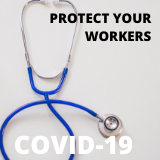
As concerns about the COVID-19 continue to rise, many employers are left to wondering what they can do to protect their workforce. This Risk Insights will examine what coronavirus is, how it spreads, and what employers can do to protect their workforce.
What Is Coronavirus?
According to the World Health Organization (WHO), coronavirus is a family of viruses that cause illnesses ranging from the common cold to more severe diseases. Common signs of infection include headache, fever, cough, sore throat, runny nose and breathing difficulties. In more severe cases, infection can cause pneumonia, severe acute respiratory syndrome, kidney failure and even death. Individuals who are elderly or pregnant, and anyone with preexisting medical conditions are at the greatest risk of becoming seriously ill from coronaviruses.
How Does Coronavirus Spread?
Although the ongoing outbreak likely resulted from people who were exposed to infected animals, COVID-19 can spread between people through their respiratory secretions, especially when they cough or sneeze.
According the Centers for Disease Control and Prevention (CDC), the spread of COVID-19 from person-to-person most likely occurs among close contacts who are within about 6 feet of each other. It’s unclear at this time if a person can get COVID-19 by touching a surface or object that has the virus on it and then touching their own mouth, nose or eyes.
CDC Interim Guidance
In order to help employers plan and respond to COVID-19, the CDC has issued interim guidance. The CDC recommendations include:
- Actively encourage sick employees to stay home. Employees who have symptoms of acute respiratory illness are recommended to stay home and not come to work until they are free of signs of a fever and any other symptoms of COVID-19 for at least 24 hours, without the use of fever-reducing or other symptom-altering medicines. What’s more, employees should be instructed to notify their supervisor and stay home if they are sick.
- Separate sick employees. Employees who appear to have acute respiratory illness symptoms (e.g., cough or shortness of breath) upon arrival to work or become sick during the day should be separated from other employees and be sent home immediately. Sick employees should cover their nose and mouth with a tissue when coughing or sneezing.
- Emphasize hand hygiene. Instruct employees to clean their hands often with an alcohol-based hand sanitizer that contains at least 60%-95% alcohol, or wash their hands with soap and water for at least 20 seconds. Soap and water should be used preferentially if hands are visibly dirty.
- Perform routine environmental cleaning. Employers should routinely clean all frequently touched surfaces in the workplace, such as workstations, countertops and doorknobs.
Additional Best Practices
In addition to following the CDC’s interim guidance, employers should consider the following best practices to help prevent the spread of COVID-19:
- Educate employees on the signs and symptoms of COVID-19 and the precautions that can be taken to minimize the risk of contracting the virus, without causing panic.
- Appoint a single individual or department as the point of contact within your organization for employee questions about COVID-19.
- Review safety programs and emergency action plans to ensure that they include infectious-disease protocols.
- Implement travel guidelines and procedures for approving travel to and from China.
Stay Informed
Despite the current low level of risk for the average American employee, it is important to understand that the COVID-19 situation evolves and changes every day. Employers should closely monitor the CDC and WHO websites for the latest and most accurate information on COVID-19.

Lawsuit Prevention Strategies for Businesses
Businesses face lawsuits that can drain resources and harm reputations. Leaders should reduce risks and

IRS Releases Employee Benefit Plan Limits for 2025
Employee benefits often come with annual dollar limits that are adjusted for inflation each year,

Wrapping Up 2024: Our Top Blog Posts of the Year
As 2024 ends, we’re highlighting the year’s top blog posts on renewal strategies, construction risks,


